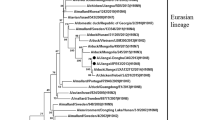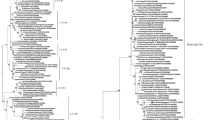Abstract
Three strains of H6N6 subtype avian influenza virus (AIV) were isolated from live-poultry markets of central China during 2009-2010. A phylogenetic analysis showed that these isolates originated from gene reassortment among different virus lineages of the H6 subtype. In an experimental infection of animals, the selected isolate was non-pathogenic for chickens and low-pathogenic for mice. The wild-type isolate was capable of replication in mouse lung without prior adaptation, and the virulence to mice increased rapidly during adaption in mouse lung. The genomes of viruses of passage 0 (P0), P4, and P8 were sequenced and compared, and virulence-related amino acid substitutions were found in multiple sites during mouse lung passage.


Similar content being viewed by others
References
Asano Y, Ishihama A (1997) Identification of two nucleotide-binding domains on the PB1 subunit of influenza virus RNA polymerase. J Biochem 122:627–634
Bridges CB, Lim W, Hu-Primmer J, Sims L, Fukuda K, Mak KH, Rowe T, Thompson WW, Conn L, Lu X, Cox NJ, Katz JM (2002) Risk of influenza A (H5N1) infection among poultry workers, Hong Kong, 1997–1998. J Infect Dis 185:1005–1010
Brown EG (1990) Increased virulence of a mouse-adapted variant of influenza A/FM/1/47 virus is controlled by mutations in genome segments 4, 5, 7, and 8. J Virol 64:4523–4533
Brown EG (2000) Influenza virus genetics. Biomed Pharmacother 54:196–209
Brown EG, Liu H, Kit LC, Baird S, Nesrallah M (2001) Pattern of mutation in the genome of influenza A virus on adaptation to increased virulence in the mouse lung: identification of functional themes. Proc Natl Acad Sci USA 98:6883–6888
Chen H, Deng G, Li Z, Tian G, Li Y, Jiao P, Zhang L, Liu Z, Webster RG, Yu K (2004) The evolution of H5N1 influenza viruses in ducks in southern China. Proc Natl Acad Sci USA 101:10452–10457
Chin PS, Hoffmann E, Webby R, Webster RG, Guan Y, Peiris M, Shortridge KF (2002) Molecular evolution of H6 influenza viruses from poultry in Southeastern China: prevalence of H6N1 influenza viruses possessing seven A/Hong Kong/156/97 (H5N1)-like genes in poultry. J Virol 76:507–516
Choi YK, Ozaki H, Webby RJ, Webster RG, Peiris JS, Poon L, Butt C, Leung YH, Guan Y (2004) Continuing evolution of H9N2 influenza viruses in Southeastern China. J Virol 78:8609–8614
Connor RJ, Kawaoka Y, Webster RG, Paulson JC (1994) Receptor specificity in human, avian, and equine H2 and H3 influenza virus isolates. Virology 205:17–23
Fouchier RA, Munster VJ (2009) Epidemiology of low pathogenic avian influenza viruses in wild birds. Rev Sci Tech 28:49–58
Gabriel G, Dauber B, Wolff T, Planz O, Klenk HD, Stech J (2005) The viral polymerase mediates adaptation of an avian influenza virus to a mammalian host. Proc Natl Acad Sci USA 102:18590–18595
Gabriel G, Herwig A, Klenk HD (2008) Interaction of polymerase subunit PB2 and NP with importin alpha1 is a determinant of host range of influenza A virus. PLoS Pathog 4:e11
Gabriel G, Klingel K, Planz O, Bier K, Herwig A, Sauter M, Klenk HD (2009) Spread of infection and lymphocyte depletion in mice depends on polymerase of influenza virus. Am J Pathol 175:1178–1186
Gabriel G, Klingel K, Otte A, Thiele S, Hudjetz B, Arman-Kalcek G, Sauter M, Shmidt T, Rother F, Baumgarte S, Keiner B, Hartmann E, Bader M, Brownlee GG, Fodor E, Klenk HD (2011) Differential use of importin-alpha isoforms governs cell tropism and host adaptation of influenza virus. Nat Commun 2:156
Gillim-Ross L, Santos C, Chen Z, Aspelund A, Yang CF, Ye D, Jin H, Kemble G, Subbarao K (2008) Avian influenza h6 viruses productively infect and cause illness in mice and ferrets. J Virol 82:10854–10863
Gonzalez S, Zurcher T, Ortin J (1996) Identification of two separate domains in the influenza virus PB1 protein involved in the interaction with the PB2 and PA subunits: a model for the viral RNA polymerase structure. Nucleic Acids Res 24:4456–4463
Gonzalez S, Ortin J (1999) Characterization of influenza virus PB1 protein binding to viral RNA: two separate regions of the protein contribute to the interaction domain. J Virol 73:631–637
Hatta M, Gao P, Halfmann P, Kawaoka Y (2001) Molecular basis for high virulence of Hong Kong H5N1 influenza A viruses. Science 293:1840–1842
Hoffmann E, Stech J, Leneva I, Krauss S, Scholtissek C, Chin PS, Peiris M, Shortridge KF, Webster RG (2000) Characterization of the influenza A virus gene pool in avian species in southern China: was H6N1 a derivative or a precursor of H5N1? J Virol 74:6309–6315
Holsinger LJ, Nichani D, Pinto LH, Lamb RA (1994) Influenza A virus M2 ion channel protein: a structure-function analysis. J Virol 68:1551–1563
Huang K, Bahl J, Fan XH, Vijaykrishna D, Cheung CL, Webby RJ, Webster RG, Chen H, Smith GJ, Peiris JS, Guan Y (2010) Establishment of an H6N2 influenza virus lineage in domestic ducks in southern China. J Virol 84:6978–6986
Hudjetz B, Gabriel G (2012) Human-like PB2 627K influenza virus polymerase activity is regulated by importin-alpha1 and -alpha7. PLoS Pathog 8:e1002488
Hulse-Post DJ, Franks J, Boyd K, Salomon R, Hoffmann E, Yen HL, Webby RJ, Walker D, Nguyen TD, Webster RG (2007) Molecular changes in the polymerase genes (PA and PB1) associated with high pathogenicity of H5N1 influenza virus in mallard ducks. J Virol 81:8515–8524
Hulse DJ, Webster RG, Russell RJ, Perez DR (2004) Molecular determinants within the surface proteins involved in the pathogenicity of H5N1 influenza viruses in chickens. J Virol 78:9954–9964
Li C, Yu K, Tian G, Yu D, Liu L, Jing B, Ping J, Chen H (2005) Evolution of H9N2 influenza viruses from domestic poultry in Mainland China. Virology 340:70–83
Li Z, Chen H, Jiao P, Deng G, Tian G, Li Y, Hoffmann E, Webster RG, Matsuoka Y, Yu K (2005) Molecular basis of replication of duck H5N1 influenza viruses in a mammalian mouse model. J Virol 79:12058–12064
Lin YP, Shaw M, Gregory V, Cameron K, Lim W, Klimov A, Subbarao K, Guan Y, Krauss S, Shortridge K, Webster R, Cox N, Hay A (2000) Avian-to-human transmission of H9N2 subtype influenza A viruses: relationship between H9N2 and H5N1 human isolates. Proc Natl Acad Sci USA 97:9654–9658
Mase M, Tanimura N, Imada T, Okamatsu M, Tsukamoto K, Yamaguchi S (2006) Recent H5N1 avian influenza A virus increases rapidly in virulence to mice after a single passage in mice. J Gen Virol 87:3655–3659
Momose F, Naito T, Yano K, Sugimoto S, Morikawa Y, Nagata K (2002) Identification of Hsp90 as a stimulatory host factor involved in influenza virus RNA synthesis. J Biol Chem 277:45306–45314
Myers KP, Setterquist SF, Capuano AW, Gray GC (2007) Infection due to 3 avian influenza subtypes in United States veterinarians. Clin Infect Dis 45:4–9
Narasaraju T, Sim MK, Ng HH, Phoon MC, Shanker N, Lal SK, Chow VT (2009) Adaptation of human influenza H3N2 virus in a mouse pneumonitis model: insights into viral virulence, tissue tropism and host pathogenesis. Microbes Infect 11:2–11
Qi X, Li X, Rider P, Fan W, Gu H, Xu L, Yang Y, Lu S, Wang H, Liu F (2009) Molecular characterization of highly pathogenic H5N1 avian influenza A viruses isolated from raccoon dogs in China. PLoS One 4:e4682
Reed LJ, Muench H (1938) A simple method of estimating fifty percent endpoints. Am J Hyg 27:493–497
Salomon R, Franks J, Govorkova EA, Ilyushina NA, Yen HL, Hulse-Post DJ, Humberd J, Trichet M, Rehg JE, Webby RJ, Webster RG, Hoffmann E (2006) The polymerase complex genes contribute to the high virulence of the human H5N1 influenza virus isolate A/Vietnam/1203/04. J Exp Med 203:689–697
Shinya K, Watanabe S, Ito T, Kasai N, Kawaoka Y (2007) Adaptation of an H7N7 equine influenza A virus in mice. J Gen Virol 88:547–553
Smeenk CA, Brown EG (1994) The influenza virus variant A/FM/1/47-MA possesses single amino acid replacements in the hemagglutinin, controlling virulence, and in the matrix protein, controlling virulence as well as growth. J Virol 68:530–534
Subbarao K, Klimov A, Katz J, Regnery H, Lim W, Hall H, Perdue M, Swayne D, Bender C, Huang J, Hemphill M, Rowe T, Shaw M, Xu X, Fukuda K, Cox N (1998) Characterization of an avian influenza A (H5N1) virus isolated from a child with a fatal respiratory illness. Science 279:393–396
Sui Z, Chen Q, Wu R, Zhang H, Zheng M, Wang H, Chen Z (2010) Cross-protection against influenza virus infection by intranasal administration of M2e-based vaccine with chitosan as an adjuvant. Arch Virol 155:535–544
Tamura K, Dudley J, Nei M, Kumar S (2007) MEGA4: molecular evolutionary genetics analysis (MEGA) software version 4.0. Mol Biol Evol 24:1596–1599
Wan XF, Dong L, Lan Y, Long LP, Xu C, Zou S, Li Z, Wen L, Cai Z, Wang W, Li X, Yuan F, Sui H, Zhang Y, Dong J, Sun S, Gao Y, Wang M, Bai T, Yang L, Li D, Yang W, Yu H, Wang S, Feng Z, Wang Y, Guo Y, Webby RJ, Shu Y (2011) Indications that live poultry markets are a major source of human H5N1 influenza virus infection in China. J Virol 85:13432–13438
Watanabe K, Handa H, Mizumoto K, Nagata K (1996) Mechanism for inhibition of influenza virus RNA polymerase activity by matrix protein. J Virol 70:241–247
Webby RJ, Woolcock PR, Krauss SL, Webster RG (2002) Reassortment and interspecies transmission of North American H6N2 influenza viruses. Virology 295:44–53
Webster RG, Bean WJ, Gorman OT, Chambers TM, Kawaoka Y (1992) Evolution and ecology of influenza A viruses. Microbiol Rev 56:152–179
WHO (2012) Cumulative number of confirmed human cases of avian influenza A/(H5N1) reported to WHO. http://www.who.int/influenza/human_animal_interface/H5N1_cumulative_table_archives/en/. Accessed 2 May 2012
Xu C, Hu WB, Xu K, He YX, Wang TY, Chen Z, Li TX, Liu JH, Buchy P, Sun B (2012) Amino acids 473V and 598P of PB1 from an avian-origin influenza A virus contribute to polymerase activity, especially in mammalian cells. J Gen Virol 93:531–540
Yen HL, Hoffmann E, Taylor G, Scholtissek C, Monto AS, Webster RG, Govorkova EA (2006) Importance of neuraminidase active-site residues to the neuraminidase inhibitor resistance of influenza viruses. J Virol 80:8787–8795
Zhang H, Xu B, Chen Q, Chen J, Chen Z (2011) Characterization of an H10N8 influenza virus isolated from Dongting lake wetland. Virol J 8:42
Zhou B, Li Y, Halpin R, Hine E, Spiro DJ, Wentworth DE (2011) PB2 residue 158 is a pathogenic determinant of pandemic H1N1 and H5 influenza a viruses in mice. J Virol 85:357–365
Acknowledgments
This study was supported by the following research funds: National 973 Project (2010CB530301), National High Technology Research and Development Program of China (863 Program 2010AA022905, 2010AA022908 and 2010AA022910), National Natural Science Foundation of China (No. 81172738 and No. 81071346), The Innovation Platform Open Funds for Universities in Hunan Province (09K022 and 11K010), International Science & Technology Cooperation Program of China (2011DFA31030) and Deutsche Forschungsgemeinschaft (SFB/Transregio TRR60).
Author information
Authors and Affiliations
Corresponding author
Rights and permissions
About this article
Cite this article
Yao, Y., Wang, H., Chen, Q. et al. Characterization of low-pathogenic H6N6 avian influenza viruses in central China. Arch Virol 158, 367–377 (2013). https://doi.org/10.1007/s00705-012-1496-3
Received:
Accepted:
Published:
Issue Date:
DOI: https://doi.org/10.1007/s00705-012-1496-3




